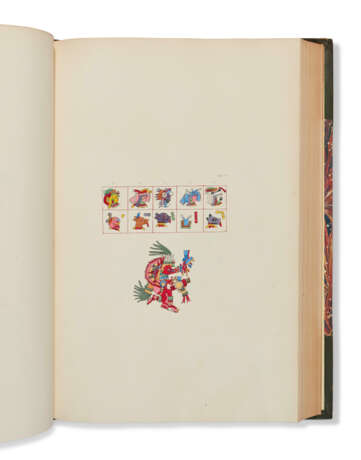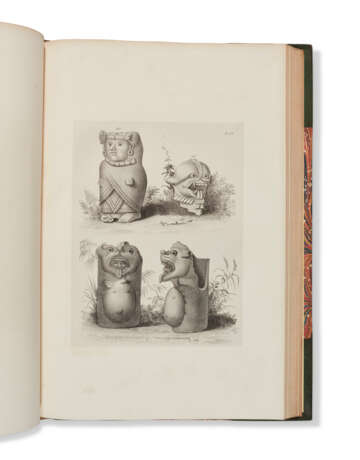ID 1079768
Lot 102 | KINGSBOROUGH, Edward King, vicomte (1795-1837)
Estimate value
€ 20 000 – 30 000
Antiquities of Mexico: comprising facsimiles of ancient Mexican paintings and hieroglyphics... together with the monuments of New Spain, by M. Dupaix... [the drawings on stone by A. Aglio.] Londres : Robert Havell et Calnagi, Son & Co [vol. I-VII], 1831 et Henry G. Bohn [vol. VIII-IX], 1848.
Exemplaire sur grand papier, avec la plupart des planches coloriées à la main, en demi-reliure de l’époque, de l’édition originale de cet ouvrage "de la plus grande magnificence" (Brunet).
La fascination de Lord Kingsborough pour les antiquités mexicaines remonte probablement à ses années passées à Oxford, où il découvre un manuscrit conservé à la Bodleian Library. Rapidement obsédé par cette découverte, il finit par s'adjoindre les services du peintre italien Agostino Aglio (1777-1857) pour reproduire d'autres manuscrits conservés dans des institutions et des bibliothèques publiques. Il l'envoie dans toute l'Europe, à Paris, à Dresde, à Rome ou encore à Vienne pour consulter et copier ces documents alors largement délaissés par les chercheurs. À son retour, il entreprend de graver ses dessins, dans l'objectif de publier ce premier véritable corpus de manuscrits mexicains.
Lord Kingsborough ne recula devant rien pour que la publication soit "de la plus grande magnificence" (Brunet) : le format du papier, le volume de l'ensemble, la qualité des illustrations, majoritairement colorées à la main, en font un ouvrage d'une grande valeur esthétique et d'une importance culturelle certaine. Il avance les frais nécessaires à la publication, mais les difficultés s'amoncellent et bientôt les premières mésententes avec ses fournisseurs apparaissent. Kingsborough est finalement arrêté à Dublin et emprisonné pour défaut de paiement. Dans sa geôle, il contracte un typhus qui lui sera fatal en 1837, six ans après la parution de sa somme monumentale.
Comme l'indiquent les pages de titre, la publication d'origine était prévue et pensée en sept tomes. Les tomes VIII et IX sont des suppléments, parus une vingtaine d'années plus tard. Il semble qu'un dixième volume ait été prévu, avant que le nouvel éditeur se ravise, là aussi certainement pour des questions de coûts.
Parmi les reproductions remarquables et les textes liés à la civilisation mexicaine que contient l'ouvrage, on évoquera notamment certaines des illustrations du volume IV, qui présente des dessins réalisés lors des trois expéditions menées entre 1805 et 1809 par Guillermo Dupaix et José Luciano Castañeda. L'ouvrage de Kingsborough est le premier à publier ces dessins d'antiquités et de monuments de la Nouvelle-Espagne. Son importance historique est indéniable, puisque c'est au travers de son succès que naît véritablement l'intérêt de l'Occident pour les civilisations d'Amérique du Sud.
Rich : Bibliotheca Americana Nova, II, 233-235 ; Sabin, I, 484-485 ("He has raised a monument which will at least preserve these unsolved symbols from destruction") ; The Athenaeum 153, 2 octobre 1830 ("This work in its magnificence recalls to mind...the splendor of the princely patrons of literature. It has no taint about it") ; Brunet, III, col. 663 ("une splendide production") ; Lipperheide, II, 1620 ; Fauvet-Berthelot "Six personnages en quête d'objets : histoire de la collection archéologique de la Real Expedicion Anticuaria en Nouvelle-Espagne".
9 vol. in-folio (533 x 358 mm). Édition originale. 742 planches, incluant : 732 lithographies (la plupart par Aglio), dont 584 coloriées à l’époque ; et 148 en noir, dont 130 sur Chine appliqué ; 4 gravures dont une coloriée ; 6 aquatintes, dont une pliante, 2 tableaux.
Reliure de l’époque par J. Wright : demi-maroquin vert à coins, dos à nerfs orné, gardes de papier marbré, tranches dorées (dos passés, frottements avec parfois accidents et manques de cuir).
Provenance : James de Rothschild (ex-libris et étiquette Ferrières).
Deluxe copy on large paper, with the vast majority of the lithographs hand-coloured at the time of publication, of this magnificent publication, without any doubt the greatest illustrated work on Mexican antiquities. "This work in its magnificence recalls to mind the splendor of the princely patrons of literature. It has no taint about it" (The Athenaeum 153, 2 October 1830).
| Place of origin: | Northern Europe, Europe, United Kingdom |
|---|---|
| Auction house category: | Books |
| Place of origin: | Northern Europe, Europe, United Kingdom |
|---|---|
| Auction house category: | Books |
| Address of auction |
CHRISTIE'S 9 Avenue Matignon 75008 Paris France | ||||||||||||||
|---|---|---|---|---|---|---|---|---|---|---|---|---|---|---|---|
| Preview |
| ||||||||||||||
| Phone | +33 (0)1 40 76 85 85 | ||||||||||||||
| Fax | +33 (0)1 40 76 85 86 | ||||||||||||||
| Conditions of purchase | Conditions of purchase | ||||||||||||||
| Shipping |
Postal service Courier service pickup by yourself | ||||||||||||||
| Payment methods |
Wire Transfer | ||||||||||||||
| Business hours | Business hours
|










